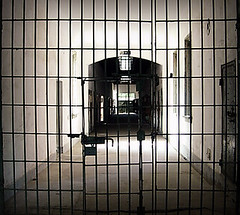“Lock ’em up and throw away the key!”
That has been the campaign rhetoric in Georgia for quite some time now, and many are glad to see it begin to fade. The stance of no tolerance coupled with long sentences is hopefully drawing to a close, despite remaining entrenched in certain quarters.
Channel 6, ABC News brings us this brief bit of coverage. You will note that while it does talk about the $88 million dollars in savings, a lot of air time is given to a policeman who embraces the hard-line– one that has failed to work for many years now.
While the hard-line attitude has been typical of Georgia politics for quite some time, the pressures of mounting facts and dwindling resources are creating support for this sort of legislation. Macon.com notes some of the particulars:
Chairman Wendell Willard said the latest version has the backing from state and local agencies, including Georgia’s district attorneys association. Youth advocates and many juvenile judges also are pushing the measure. And Gov. Nathan Deal has included money in his 2014 budget proposal to help expand the community programs.
“We hope we are making major strides in finding better practices,” Willard said.
Georgia spends more than $90,000 per year on each youthful offender behind bars. It costs about $30,000 to serve a delinquent at a non-secure residential facility. About 65 percent who are released end up back in jail, Willard said, a rate he called “totally unacceptable.” The new model, he told a packed hearing room at the Capitol, should “save lives that would otherwise continue down a road of ruin.”
Among other measures, the redesign would place a greater emphasis on access to drug treatment and mental health counseling. Some residential programs still would involve confinement, but differ from adult short-term jails and long-term prisons.
Willard’s bill now moves to the Rules Committee, the panel that sets the House debate calendar. The measure is not expected to encounter any resistance.
If the proposed changes pass the rest of their legislative challenges, it will bring Georgia in line with the national trend toward treatment and counseling instead of incarceration. More than twenty states have made significant changes to their juvenile justice programs over the last decade in an attempt to reverse the damage caused by harsh laws enacted in the ’80s and ’90s.
Georgia, even with these changes, will reamin one of fewer than a dozen states that cap the juvenile system’s jurisdiction at 16 years old. The majority of states set the cap at 17 .
Related articles
- Georgia’s Juvenile Justice Overhaul Clears 1st Hurdle (wtvy.com)
- Juvenile justice overhaul moving at Georgia Capitol (onlineathens.com)
- Top Ga. judge urges juvenile justice reform (chronicle.augusta.com)
- Bill Set to Overhaul Georgia’s Juvenile Justice System (atlantablackstar.com)
- Georgia juvenile justice reform clears hurdle (chronicle.augusta.com)















 The economic side of the penal system is something we look at a lot. In so many cases, the return of preventative programs vastly outstrips the return we see from imprisoning people. Our documentary is titled
The economic side of the penal system is something we look at a lot. In so many cases, the return of preventative programs vastly outstrips the return we see from imprisoning people. Our documentary is titled  It is no secret that there is a link between education and one’s eventual path in life. Nowhere is this more painfully asserted than by the number of dropouts that end up in jail or prison. In Alabama, the officials have taken notice, and are using a short documentary film to communicate the “stay in school and out of prison” message to the students. Rick Harmon, a reporter for
It is no secret that there is a link between education and one’s eventual path in life. Nowhere is this more painfully asserted than by the number of dropouts that end up in jail or prison. In Alabama, the officials have taken notice, and are using a short documentary film to communicate the “stay in school and out of prison” message to the students. Rick Harmon, a reporter for 







